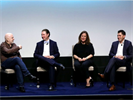Arun Sudhaman 09 Oct 2013 // 2:52PM GMT
The impact of digital media trends on the PR agency model is not an under-explored area, but a new study provides a useful barometer of the pace of change among UK firms, and the challenges that still need to be addressed.
The PRCA Digital Report, which polled 136 agency and in-house PR pros, was unveiled last night and triggered an animated panel discussion among some of the UK industry’s leading digital PR executives, which was chaired by Ketchum’s Danny Whatmough. One finding, in particular, stood out — that many brands are not totally convinced of the digital capabilities of their PR agencies.
While digital budgets among comms clients are increasing fast, they are less likely to be spent on services such as social network strategy and online reputation management. Instead, attracting more spend are web design and build (79 percent), SEO (67 percent), monitoring and listening to customers (67 percent) and content creation (64 percent).
Unsurprisingly, those results are having an impact on how PR agencies invest for growth. 72 percent of PR firms, for example, now offer SEO services, up from 19 percent five years ago. 63 percent, meanwhile, provide web design and build, compared to 16 percent five years ago. Mobile marketing and digital analytics, meanwhile, are expected to be the key growth areas over the next five years.
For MindShare head of social strategy Jed Hallam — who still considers himself a ‘PR person’ after working at VCCP Share and Wolfstar — the results indicate an “identity crisis” among PR agencies.
“Having to offer everything is insane,” said Hallam. “Just offer the things that you are good at.”
That might be easier said than done. The influx of digital talent into the PR industry is reflected in the service expansion at many agencies, a trend we first documented in detail back in 2010. What can go unreported, though, are the many cultural difficulties that firms have faced in trying to integrate developers and data geeks, and the business model changes that might be required.
As Hill+Knowlton Strategies interactive lab ECD Candace Kuss pointed out, “having the facility to do the whole spectrum for your client should probably just grow organically, rather than going out and getting 50 developers.”
“Hiring lots of data geeks, you will get cultural friction,” added Hallam. “If you’re a PR agency, bringing in lots of data analytics doesn’t make sense when you can partner with people.”
The partnership approach was also supported by Ketchum EMEA president David Gallagher, who noted that “it’ll always be cheaper to find developers and designers somewhere other than your home market.”
“There are diminishing returns in investing in those types of specialist skills in technology,” continued Gallagher. “We’d probably never sink a lot of money into that.”
Outsourcing more technical skills to other agencies, though, may have its drawbacks. 33 Digital MD Peter Sigrist noted that the partnership approach does not always best serve client needs or, indeed, the longer term requirement that the PR agency model must change.
“We couldn’t work without developers in our team,” said Sigrist. “If you’re going to hack your way to an answer, you need people who are going to go off and figure it out. And it feeds back to the rest of the team who aren’t so technically minded.”
Sigrist admitted that PR firms are getting to grips with “different types of people with different aspirations.” And it is difficult to argue against the notion that a more varied talent base would help PR agencies play a more central brand-building role.
That much became clear when the panel discussed the PR industry’s continued challenges, despite the perception that, as Hallam put it, “the skills you are taught as a PR person are invaluable, especially in a world where you have direct access to consumers.”
“We take false confidence sometimes in our training as PR people and journalists,” responded Gallagher. “There’s a diminishing supply of talent that is actually trained in classic PR and it will be extinguished in five years.”
If agencies are to become more versatile, furthermore, they probably need to do a better job at addressing some traditional failings. “I think the thing that’s holding back PR is a defensive nature,” said Sigrist. “This sense that we don’t want to lose more than we want to win. Just make something everybody wants and don’t worry if, this month, it didn’t get as much coverage.”
Despite an approach that should, theoretically, be media-neutral, many PR firms continue to see a world of competing disciplines. “No one else is really bothered about that conversation,” said Hallam. “We’re now in a world where a good idea is a good idea. We just need to stop worrying about whether its PR or advertising or digital. We just need good ideas.”
Yet, that situation is not helped by Gallagher’s assertion that “most ideas we sell to clients suck.”
“We need to get less hung up on whether the answer is a digital answer, an advertising answer or an earned answer,” said Gallagher. “And just answer the question.”
Are brands ready for that? Compounding all of these issues, says Hallam, are companies that remain “ill-informed about what PR is.”
And, interestingly, Hallam noted that the “psychology of price” — where lower budgets lead to lesser perceived importance, also counts against PR firms when they are compared to advertising and media agencies.
With that in mind perhaps Gallagher had the right idea when he mentioned that the ideal media model should really begin with earned before spreading to paid, shared and owned. When it comes to fighting commoditisation, I suspect EPSO sounds better than PESO.


































.jpg)

















